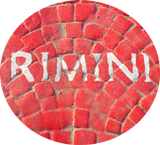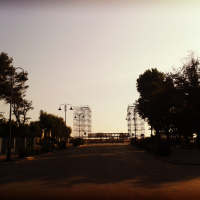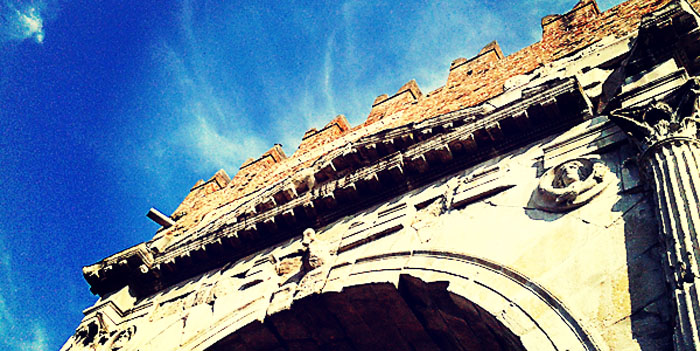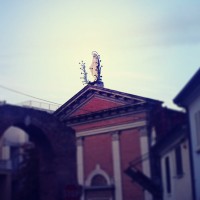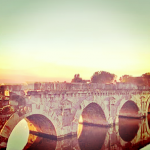San Leo
One of the most fascinating and beautiful places to visit, in our humble opinion, when in Rimini, is the nearby jewel of San Leo. The town, with its spectacular fortress perched on top of the ancient Mons Feretrius mountain, is a former capital of the Italian kingdom (from 961-963), and home to centuries of art, history, and culture.
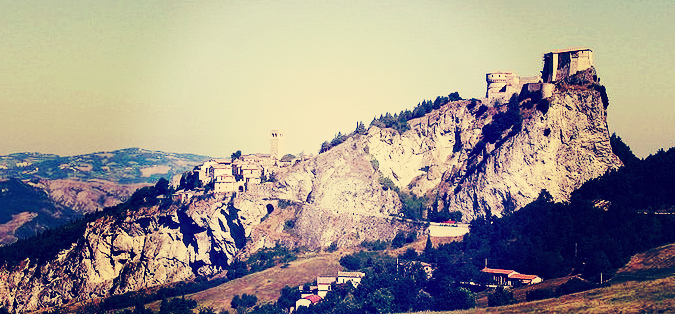
San Leo’s Origins and history
The legend surrounding the foundation of San Leo suggests that Leo, a stone-cutter from Dalmatia,along with his friend Marino, in the 3rd or 4th Century AD headed inland from the port of Rimini (where both were working as stone cutters on the new walls of the city) in order to spread the word of God. These early Christians, who had fled persecution in Dalmatia, founded, according to the legend, both San Marino and San Leo.
San Leo, though, has always been a valued location thanks to its strategic importance overlooking and helping to control the Val Marecchia. Its height is an obvious advantage (639m), but the mountain, probably formed about 20thousand years ago) also has rich water sources and fertile fields. There were almost certainly pre-Christian settlements here, as shown by the traces of a Roman temple (dedicated either to the Godess Fonta ad acquas or to Jupiter Feretrius).
During the struggles for control over Northern Italy that followed the fall of the Roman Empire, San Leo played an important role. It moved variously from the control of the Byzantines, to the Lombards and through to the Papacy. The donation of Pepin gave control of the mountain to the Papacy, and established the diocese of Monte Feltro (Mona Feretri). In 950 Berengar II, a Lombard, took the title of King of Italy – and moved his capital to San Leo in an effort to resist the invasion of the German King and Emporor Otto I. Berengar stayed blockaded and under siege in San Leo for two years, before the political situation forced him to bow down and swear an oath of loyalty to the German Emporor.
San Leo, as we’ve seen, has often been considered a chess piece, and has been won and lost variously by Longobards and Byzantines, Ghuelfs and Ghibbelines, MonteFeltro and Malatesta, and the Popes.
Some of the Sights to See in San Leo
The Romanesque Parish Church (Pieve) of Santa Maria Assunta
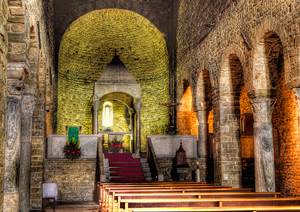 This is a spectacularly well kept and restored early christian church dates back to the Carolingian period (with legend suggesting that the remains of an apse cut into the bare rock of the mountain date back to San Leo himself in the 4th Century). Inside the church, which is nowadays stark and austere but which would probably have been boldly decorated in its heyday, you’ll find a cool and simple atmosphere which makes it feel like a deeply spiritual place. The church follows a basilica plan with three apses deocrated by small arches and pilaster strips. The Ciborium (a free standing canopy supported by columns), which dates back to 822, is spectacular and includes a dedication of the church to Jesus and the Virgin Mary from the Duke Orso during the reign of Emperor Charles III – otherwise known as Charles the Fat).
This is a spectacularly well kept and restored early christian church dates back to the Carolingian period (with legend suggesting that the remains of an apse cut into the bare rock of the mountain date back to San Leo himself in the 4th Century). Inside the church, which is nowadays stark and austere but which would probably have been boldly decorated in its heyday, you’ll find a cool and simple atmosphere which makes it feel like a deeply spiritual place. The church follows a basilica plan with three apses deocrated by small arches and pilaster strips. The Ciborium (a free standing canopy supported by columns), which dates back to 822, is spectacular and includes a dedication of the church to Jesus and the Virgin Mary from the Duke Orso during the reign of Emperor Charles III – otherwise known as Charles the Fat).
The Duomo, Cathedral of San Leone
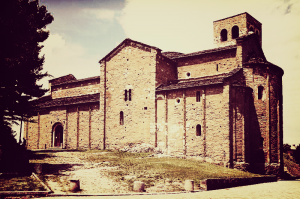
BUilt in 1173, and dedicated to the Bishop Valfredus (or Gualfredus) – there’s a small bust of the Bishop above the entrance – this church was erected over the remains of an earlier 9th Century church and is a splendid example of the Lombard Romanesque style (or First Romanesque as it’s sometimes also known), which is characterised by thick walls, lack of sculpture and the presence of rhythmic ornamental arches known as a Lombard band. It features hanging arches, splayed one-and-two-light windows, with a nave and two aisles divided by bundle pllars and the first examples in Italy of acute arches. In the Duomo, under the stairs on the left, is the cover of the sarcophagus of San Leo, whose remains were transferred by the Emporor Henry II, from the Pieve di Santa Maria Assunta to Voghenza near Ferrara in 1014). There is also an impressive 13th Century Crucifix, which was also used as an emblem by the Montefeltro family later in the 1300’s.
Standing apart from the Duomo is the square based bell tower, whose spiral stone stairs lead up to give a wonderful view of the town and the surrounding Marecchia valley.
The Fortress of San Leo
As we’ve seen from the brief history of San Leo, it’s primary importance was as a fortress, and different families and rulers have all worked and added to the actual fortress which nowadays remains an awe inspiring site. The first fortress was probably built during the time of the Lombards, but the foundations of the current fortress are more probably dated back to the Malatesta reign in the late 1300s (to put it in perspective, Rimini’s Castel Sismondo was built around 1446),but was primarily built by the famous Sienese architect & engineer Francesco di Giorgio Martini , under orders of Federico di Montefeltro in the late 1470s (at the same time as the rebuilding of the town of Cagli). Martini was Federico’s architect and responsible for military buildings like fortresses in San Leo, Gubbio, Mondavio, and Pergola as well as the famous Ducal palaces of Urbino, and Gubbio, and the churches of Santa Chiara in Urbino and San Sebastiano in Valle Piatta in Siena. Martini was the author of ‘a treatise on civil and military architecture’ which inaugurated a new era in fortification and was much admired by Leonardo Da Vinci.
The View from Cagliostro’s Window in the Papal Prison of San Leo
The Fortress at San Leo employs the natural cliff face, bulwarks, corbels and machicolations (which as we all know are floor openings between the supporting corbels of a battlement, through which stones could be dropped on attackers at the base of a defensive wall)along with the innovation of elbow-shaped walls as opposed to the largely circular design previously used. The fortress is one of the best examples of Martini’s ideas put into practice, with its squat round towers and base giving off the sense of impenetrability, but not of claustraphobia (the architect had to think equally about those within the fortress as those without).
San Leo as a fortress more often changed hands due to events elsewhere, rather than falling into enemy hands itself. Indeed one of the only times it was taken by force was during an intrepid raid on the 22 October 1441 when Federico da Montefeltro’s forces, led by Matteo Grifoni di Sant’Angelo in Vado, scaled the mountain during th night and took the Malatestas by surprise.
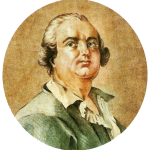
Giuseppe Balsamo – also known as Alessandro, Conte di Cagliostro
During the Risorgimento the prison became home to many activists who were struggling to create a new kingdom of Italy – something the Papacy, with its extensive territory was keen to avoid. One such prisoner was Orso Teobaldo Felice Orsini, the noted Italian patriot and author. Orsini was a member of the Carbonari, a secret revolutionary society dedicated in Italy to the Italian nationalism. He was imprisoned for in the early 1840s in San Leo result of his activities, but was released with the Amnesty of Pope Pius IX.
The Romagnolo revolutionary continued his activities, and was later captured by the Austro-Hungarian authorities and placed in their supposedly inescapable fortress at Mantova, from where he made a daring escape which made him famous throughout Europe. He made his way first to England, and then on to Paris where, in a split with Mazzini, he decided to try to assasinate the French Emporor Napoleon III. Orsini threw a bomb into a crowded theatre in his attempt, but failed, killing 12 people in the process and injuring many more. From his Parisian prison cell he issued a famous declaration to Napoleon III promising that ‘Until you liberate Italy the peace of Europe and your own tranquility will be but a chimera‘. He was guillotined in Paris in 1858.
Today the fortress of San Leo hosts a museum but its real appeal lies in its history and sturdy architecture.
How to get to San Leo from Rimini
By Public Transport
There is a public bus, the #165 which goes from the Train Station to San Leo (and onwards to Carpegna). You’ll need an extraurbana ticket which should cost about €0.90
During the summer months the private bus line Bonelli Bus operates a return trip bus on Wednesdays, at a ticket cost of €9.00.
By Car
Head out of Rimini on Via Marecchiese, taking the SP258 towards Villa Verucchio. Continue on with the SP258 Statale Marecchia until you get to Villanova where you need to take a left onto the SP22 which will take you up to San Leo. The trip is roughly 32 km.
By Bicyle
If you’re feeling particularly energetic and have the right kind of bike, you can take the Visita A Cagliostro bicycle route proposed by the Regional Tourist Authority – or at least a part of it, as the whole itinerary is a 105km round trip! The itinerary sets out from Rimini along the ss16 towards S. Salvatore and Ospedaletto, climbing up to Faetano, Montegiardino and Fiorentino (at 580mt) before swooping down to Castello di Montemaggio (244mt) and climbing back up tow San Leo (580mts) and 32 kms from Rimini. Not for the faint-hearted!
